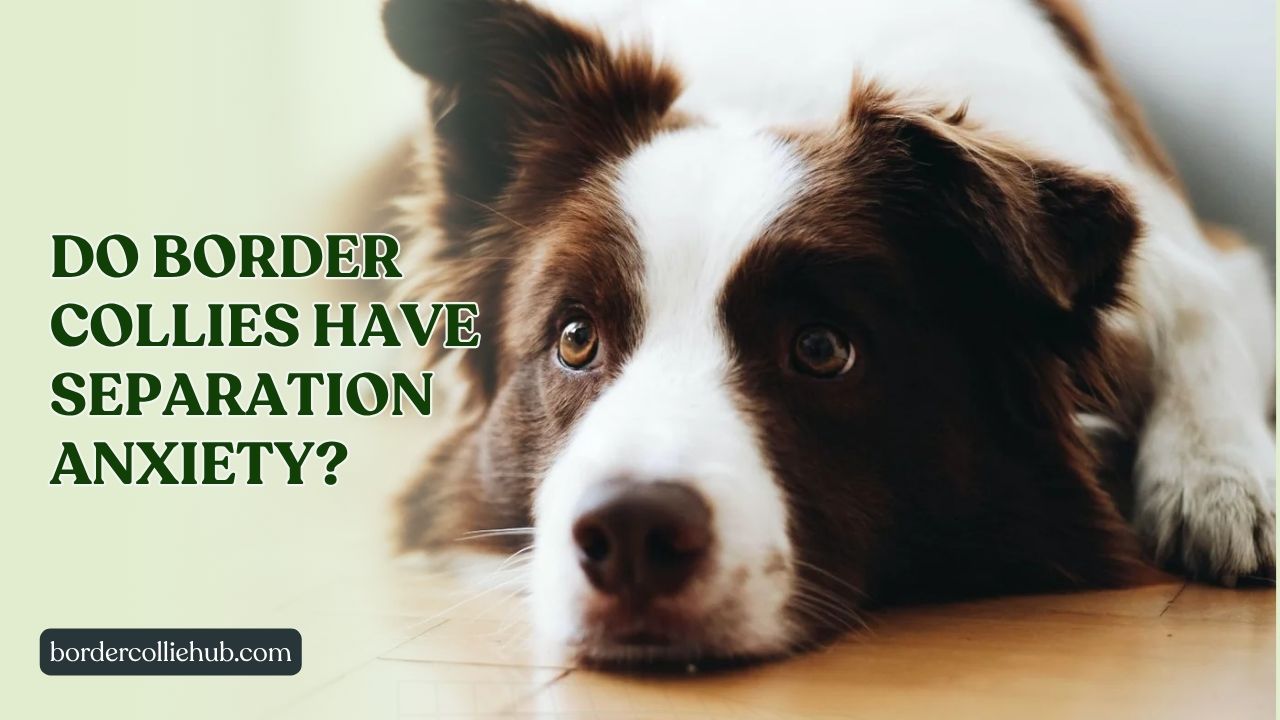Do Border Collies have separation anxiety? Border Collies can develop separation anxiety, especially if left alone too long or not given enough mental and physical exercise. This common condition causes stress and behaviors like barking, chewing, or pacing. Fortunately, with the right training and care, you can help your Border Collie feel calm and secure when alone.
Many Border Collie owners face the frustration of seeing their loyal dog upset when left alone. These dogs are smart and social, so they often struggle with being separated from their family. If your Border Collie shows signs of anxiety, you’re not alone—and there are simple, practical ways to ease their worries. In this article, we’ll explore why separation anxiety happens, how to spot it, and what you can do to help your dog feel safe and happy. Let’s walk through each step with real examples and expert tips.
Do Border Collies have separation anxiety? What are the Causes?

Separation anxiety in Border Collies happens for many reasons. One major cause is their strong herding instincts. These dogs are bred to stay close to their family and keep them safe. When left alone, they feel worried and unsure. Without enough mental and physical exercise, their anxiety can get worse. Border Collies need a lot of daily activity to stay calm and happy.
Early life experiences also matter. Dogs that spent time in shelters or had traumatic events may be more likely to develop separation anxiety. How owners interact with their dog can also play a role. If a dog becomes too dependent on their owner or gets upset every time the owner leaves, it may trigger anxiety. Learning these causes helps owners better support their dog’s mental health.
Common Signs of Separation Anxiety in Border Collies
Behavioral Indicators
Border Collies with separation anxiety show clear signs. They may bark or howl loudly when left alone. This is their way of calling for you. Some dogs chew on furniture, doors, or their bedding. Others try to escape by scratching walls or digging at doors. Pacing back and forth is another common sign of distress.
Physical and Emotional Symptoms
Along with behavior, there are physical signs to watch. Your dog might pant heavily, drool more than usual, or shake. Some dogs have accidents inside the house even if they are fully trained. They may also seem restless or clingy right before you leave.
Symptoms, Causes, and Recommended Actions
| Symptom | Possible Cause | Recommended Action |
|---|---|---|
| Excessive barking | Stress from separation | Use gradual desensitization training |
| Chewing furniture | Boredom or anxiety | Provide chew toys and mental stimulation |
| Restlessness | Fear of being alone | Practice short separations and build up time |
| Accidents indoors | Stress affecting house training | Use positive reinforcement and routine |
| Shaking or panting | Physical anxiety symptoms | Calming aids or vet consultation |
How Long Can You Leave a Border Collie Alone?

Border Collies are very social and active dogs. They do best with limited alone time. For adult Border Collies, it is generally safe to leave them alone for up to 4 hours. Puppies need much shorter periods, usually less than 2 hours, because they are still learning control and can get anxious faster.
Leaving your dog alone longer than this can increase the chance of separation anxiety and other behavior problems. Border Collies especially need mental stimulation and social interaction daily. If you must be away longer, consider doggy daycare, a pet sitter, or interactive toys to keep your dog busy.
The ASPCA recommends that dogs are not left alone for extended hours to avoid stress and anxiety.
A helpful chart to understand alone time limits: Dog Age, Maximum Alone Time, and Reasons
| Dog Age | Max Alone Time | Reason |
|---|---|---|
| Puppy (under 6 months) | Less than 2 hours | Need frequent bathroom breaks and socialization |
| Young Adult (6 months – 2 years) | 2 to 4 hours | Still learning independence |
| Adult (2 – 7 years) | Up to 4 hours | Can tolerate short alone periods |
| Senior (7+ years) | Varies | May need more attention and comfort |
Providing regular walks, playtime, and mental challenges before alone time helps reduce anxiety and keeps your Border Collie balanced.
Is It Separation Anxiety or Just Boredom?

Sometimes, Border Collies act anxious when left alone, but the cause might be boredom rather than true separation anxiety. Separation anxiety means the dog feels strong fear and stress when separated from their owner. Boredom, on the other hand, happens when a dog lacks mental or physical activities. Both can cause unwanted behaviors like barking or chewing, but they need different approaches.
To tell the difference, watch how your dog acts. Dogs with separation anxiety often panic as soon as you prepare to leave. They may show signs of distress like pacing or scratching at doors. Bored dogs usually get restless after a while and may become destructive because they want something to do.
Quick Self-Test for Owners
Ask yourself these five questions to help decide if your dog has separation anxiety:
- Does your dog panic right before or just after you leave?
- Are there signs of stress, like drooling or shaking?
- Does your dog show these behaviors only when you are gone?
- Is your dog well exercised but still anxious?
- Do your dog’s behaviors improve with more mental stimulation?
If you answer “yes” to most, your Border Collie likely has separation anxiety.
How to Treat and Prevent Separation Anxiety in Border Collies
Treating separation anxiety takes patience and care. The goal is to help your dog feel safe when alone. Training and behavior changes are key.
Training and Behavior Modification
Start with gradual desensitization. Practice short separations, beginning with just a few seconds and slowly increasing the time. Reward calm behavior with treats and praise. Avoid making a big deal when you leave or return to keep your dog calm.
Mental Stimulation and Enrichment
Border Collies need lots of mental challenges to stay happy. Use puzzle toys, scent games, and interactive feeders. Exercise before leaving helps burn extra energy. A tired dog is less likely to be anxious.
Tools & Products That Can Help
Products like calming vests, dog cameras, and soothing music can reduce stress. Crate training can provide a safe space if done properly. Dog daycare or pet sitters are good options if you will be gone long.
When to Consult a Veterinarian or Dog Behaviorist
If your dog’s anxiety is severe, consult a professional. A vet can check for medical issues and may suggest medication. Certified dog behaviorists can create personalized training plans.
For more advice, see VCA Hospitals’ separation anxiety tips.
Can Border Collie Separation Anxiety Be Cured?
Separation anxiety can rarely be “cured,” but most dogs improve a lot with treatment. Success depends on how soon you start and how consistent you are. Many Border Collies respond well to training and lifestyle changes.
It’s important to have realistic goals. Complete elimination of anxiety might take months. But even small progress means a happier dog and family. Many owners share hopeful stories of their dogs learning to stay calm alone.
| Treatment Method | Description | Expected Result |
|---|---|---|
| Gradual Desensitization | Slowly increase alone time while rewarding calmness | Reduced panic and stress |
| Mental Stimulation | Use toys and activities to tire the dog mentally | Less boredom and destructive behavior |
| Calming Tools | Vests, music, cameras, crate training | Lower anxiety levels |
| Professional Help | Vet or behaviorist for severe cases | Personalized plan and medication if needed |
Final Thoughts
Helping your Border Collie feel safe and happy starts with understanding their needs. These dogs thrive on routine, exercise, and mental challenges. Keeping a consistent schedule reduces anxiety because your dog knows what to expect each day. Also, your own calm and confident attitude affects your dog’s mood—dogs can sense stress and worry.
Remember, separation anxiety is common, but with patience and care, your Border Collie can learn to be comfortable alone. Small changes like daily walks, fun games, and gentle training go a long way. Support your dog with love and understanding, and you will build a stronger bond that lasts a lifetime.
Frequently Asked Questions
What age do Border Collies show signs of separation anxiety?
Separation anxiety can start at any age but is most common in young dogs and puppies who are still adjusting to their environment. Changes like moving or a new family member can also trigger it in adult dogs.
Will getting a second dog help my Border Collie’s anxiety?
Sometimes a second dog can provide company and reduce loneliness. However, it is not a guaranteed fix. Both dogs must be a good match, and you still need to address the anxiety directly.
Do female Border Collies get more anxious than males?
There is no clear evidence that females are more anxious than males. Anxiety depends more on individual personality, training, and environment than gender.
Are Border Collies better with crate training for anxiety?
Many Border Collies find crates comforting if introduced correctly. A crate can be a safe, quiet space that helps reduce anxiety. However, forcing a dog into a crate without positive training can worsen stress.
How long does it take to treat separation anxiety in dogs?
Treatment time varies widely. Some dogs improve in a few weeks, while others may take several months. Consistency and patience are key to success.
